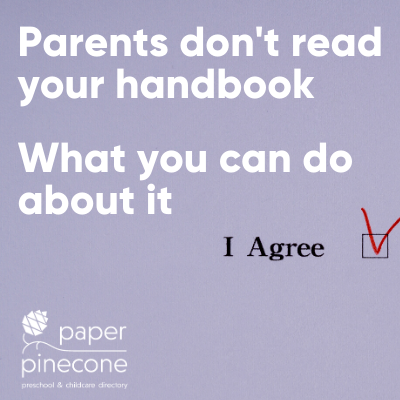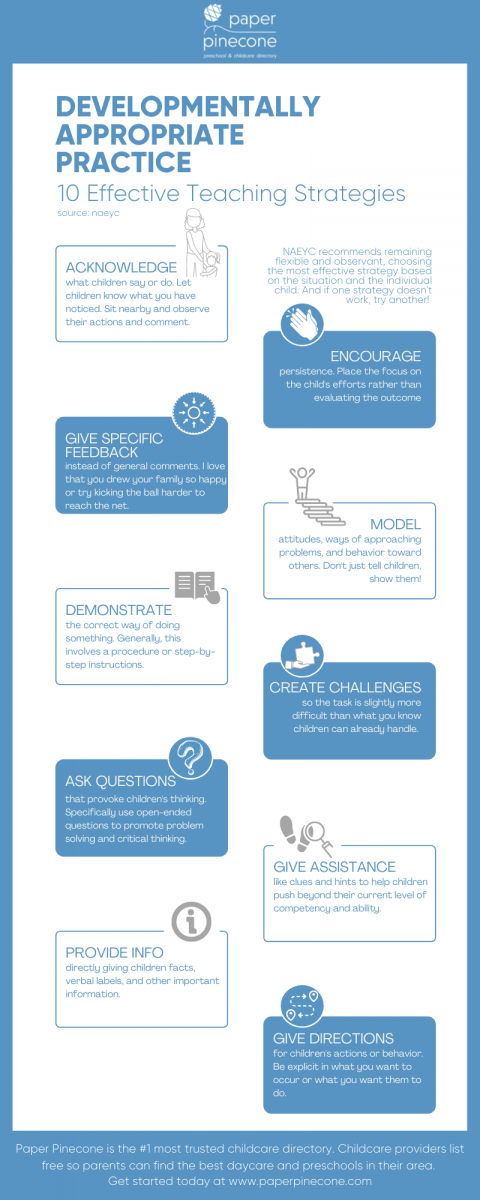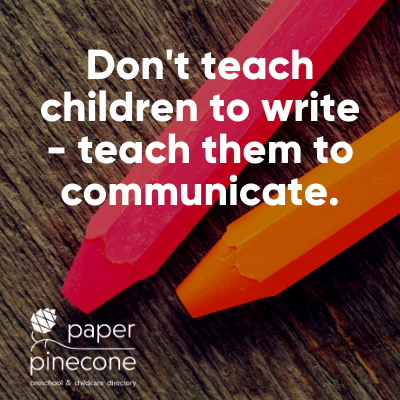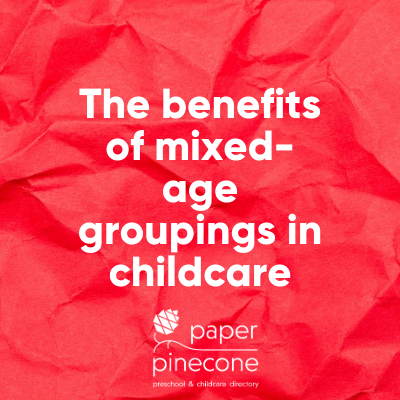What is Developmentally Appropriate Practice?
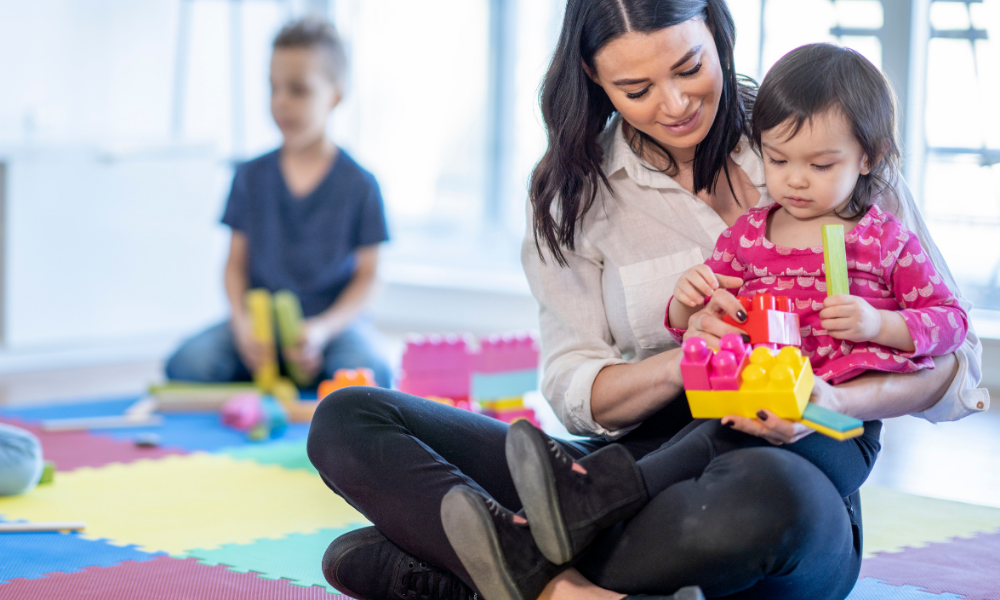
Published Date: 03/15/21
A Guide to Understanding Developmentally Appropriate Practice in Early Childhood Education
Early childhood teachers want to provide the children in their classrooms with the best care and education possible. Teachers create classrooms that provide each child with a nurturing environment that fosters their development and allows them to thrive. They accomplish this by following “developmentally appropriate practice.”
What is Developmentally Appropriate Practice?
In the 1980’s the National Association for the Education of Young Children (NAEYC) established their original position statement on developmentally appropriate practice. Initially, the statement focused on 4 and 5 year olds but was eventually expanded to include birth through 8 years old. As research advances, NAEYC continually updates their position statement. Most recently, NAEYC defines developmentally appropriate practice as the following: “methods that promote each child’s optimal development and learning through a strengths-based, play-based approach to joyful, engaged learning.” Through these methods teachers strive to create learning environments that meet the individual needs of the children in their classrooms while also cultivating and nurturing their strengths.
YOU’LL ALSO ENJOY: UNDERSTANDING MILDRED PARTEN’S SOCIAL BEHAVIOR THEORY OF PLAY
Developmentally appropriate practices consider the complexity with which early childhood teachers must navigate each day in their classrooms. Teachers must work with each child, and their families, to meet their needs and understand them as individuals. They can do this by crafting engaging lessons, and providing children with the opportunities to make choices throughout the day. Allowing each child to make choices helps them build on their strengths while carefully nurturing the skills that need further development.
What are the core considerations of developmentally appropriate practice?
NAEYC outlines the following 3 core considerations:
- “Commonality in children’s development and learning” – This includes early childhood teachers understanding the research on the ways in which all children’s learning and development occurs. In addition, they must simultaneously understand the way that social and cultural contexts influence learning and development. It is important to understand that most research is based on norms catered to a Western scientific-cultural model, and applying these norms to non-Western cultures is problematic; often any deviation from the Western norm is viewed as a deficit in skill, which further perpetuates privilege and systems of power that help to maintain structural inequities. The cultures, backgrounds, and experiences of all children must be considered when utilizing research to inform decision making in the classroom.
- “Individuality reflecting each child’s unique characteristics and experience” – Teachers must recognize each child as an individual by understanding the intricacies that comprises each child, and nurturing each of them in a way that genuinely makes them feel like they are a valued part of the classroom community. Teachers must celebrate the diversity in their classroom; each child brings different personalities, cultural backgrounds, abilities, and approaches to learning. Classrooms must be inclusive.
- “The context in which development and learning occur” – Understanding how social and cultural contexts affect learning and development in children is at the core of this consideration. Each child brings their personal cultural contexts (this includes their family’s culture) and are impacted by the broader cultural context of society (racial, economic, historical, and political). In addition to understanding the social and cultural contexts that each child brings to the classroom, early childhood teachers must understand that they also bring their own cultural contexts, and biases, that affect the classroom dynamic.
RELATED: TEACHING THE DIFFERENCE BETWEEN EQUALITY, EQUITY, AND JUSTICE IN PRESCHOOL
What are the 10 effective teaching strategies of developmentally appropriate practice?
- Acknowledge and engage with children in the classroom.
- Encourage students in their learning journey.
- Give specific feedback that helps children understand what they are doing well and how to adjust when necessary.
- Model attitudes and expectations of behavior.
- Demonstrate how to correctly do various tasks.
- Create or add challenge to scaffold children’s learning.
- Ask questions to help children think critically about what they are learning.
- Give assistance and guide children through their understanding.
- Provide information that provides facts, and details.
- Give directions to elicit the actions and learning desired.
“Our favorite children’s book!” – snail & the whale"
How can developmentally appropriate practice be used in the early childhood classroom?
In an early childhood classroom that effectively follows developmentally appropriate practices, teachers are intentional about how they teach. Each classroom will function differently, as there is not a one size fits all approach. However, there are broader similarities, such as: classrooms are child-centered where the teachers act as guides, play is at the core of all learning, children are engaged and happy, and the classrooms are inclusive.
Developmentally appropriate classrooms are child-centered, and teachers are focused on guiding children through their learning. By acting as a guide, each child is afforded the opportunity to showcase their interests, and knowledge, at a pace that suits their individual development. When a child is on the edge of their competency, teachers can help by scaffolding their learning. Worksheets should not be used, instead hands on experiences should be provided and children should be allowed to play with their peers often.
Play is at the core of all developmentally appropriate classrooms. Through play children develop a variety of skills (problem solving, social emotional, gross and fine motor) and play allows for them to make choices. Children are more likely to stay engaged for longer periods of time if they are given opportunities to make choices based on their interests and preferences.
An article featured in a journal by The Society for Research in Child Development indicates that classroom engagement is “associated with school readiness.” Therefore, keeping children engaged in the classroom is a top priority. Activities that meet children where they are, regardless of development and abilities, are essential to maintaining their engagement and furthering their development.
Classrooms must be inclusive. As mentioned, social and cultural contexts must be considered when teachers are deciding how to structure their classrooms. In addition to those contexts, teachers must also consider where the children are in their development and create an environment and plan activities that are accessible for all abilities.
"Unlock creativity with wooden building blocks set"
What are examples of developmentally appropriate practice?
Developmentally appropriate classrooms offer a variety of activities, and learning opportunities, that are child-centered, engaging, and inclusive. Here are some examples:
- Providing process-focused, open ended, art projects. The focus is not placed on what the children are producing. It is much more important that children explore the materials and tools they are using. Each child will create projects that are unique to their perspectives and interests.
- Supporting diversity in the classroom. Teachers can do this in many ways. For example, if a student speaks a second language at home, their teacher can incorporate their home language in the classroom. The books and dolls that are available in the classroom should reflect the cultures of the students in the classroom.
- Arranging the classroom furniture so that it is accessible for all children. All children should have the opportunity to explore the classroom to the best of their abilities.

RELATED: CREATIVE A PRESCHOOL INCLUSIVE OF CHILDREN WITH SPECIAL NEEDS BENEFITS ALL CHILDREN
Developmentally appropriate classrooms are welcoming spaces that allow children the opportunity to express their individuality. Teachers act as guides, encouraging children to develop and explore their interests. The cultures and backgrounds of the children are always respected and incorporated into the classroom. Teachers who prioritize developmentally appropriate practices are creating the best learning environments for children to thrive.
FAQ's About Developmentally Appropriate Practice
1) Why is it important to use Developmentally Appropriate Practice in early childhood education?
Developmentally Appropriate Practice (DAP) is important in early childhood education because it recognizes that children learn and develop at their own pace and in their own unique way. By using DAP, educators can create a learning environment that is tailored to the individual needs of each child, which can lead to better outcomes in terms of academic achievement, social-emotional development, and overall well-being. DAP also helps to ensure that children are not pushed too hard or too fast, which can lead to stress and frustration, and can even hinder their development.
2) What are some examples of Developmentally Appropriate Practice in action?
Some examples of Developmentally Appropriate Practice in action include providing hands-on learning experiences, using play-based activities to teach academic and social emotional concepts, adapting instruction to meet individual needs and abilities, and creating a safe and supportive learning environment.
By Crystal Teegarden
 Crystal is a gentle parenting mama who loves reading, cooking, and exploring new trails with her husband and son. She is from Los Angeles but currently lives in Portland, OR where she is eating all the vegan food.
Crystal is a gentle parenting mama who loves reading, cooking, and exploring new trails with her husband and son. She is from Los Angeles but currently lives in Portland, OR where she is eating all the vegan food.
Paper Pinecone is the #1 most trusted childcare directory. Childcare providers list free so parents can find the best daycare and preschools in their area.
- stacey's blog
- Log in or register to post comments

